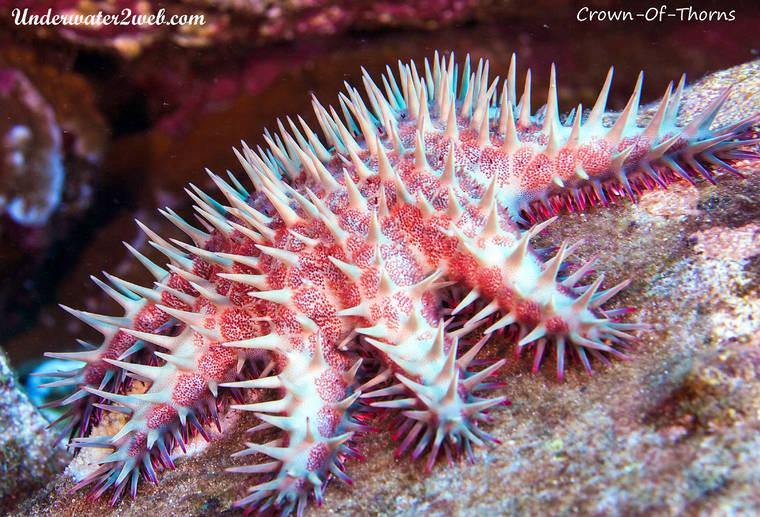Meet the crown-of-thorns starfish. But dont ever touch one. This huge, 18-inch-wide starfish comes covered in sharp venomous spines that can land you in the hospital if you tried to pick one up off of the reef.
Meet the crown-of-thorns starfish. But don’t ever touch one. This huge, 18-inch-wide starfish comes covered in sharp venomous spines that can land you in the hospital if you tried to pick one up off of the reef.
This large starfish is native to Hawai‘ i but not often seen unless there is an outbreak of them on the reef, which happens naturally from time to time. This may not be good for the corals because this starfish eats coral polyps, which are the tiny live coral animals. With its 12 to 20 spiky arms it can cover up an entire live coral and digest the coral polys, leaving only the white skeleton left behind. The crown-of-thorns has rows of tube feet tipped with suckers to move over the reef and hold onto the live corals. These starfish can move quite quickly and are light sensitive. If they loose one of their many legs they will simply grow a new one. They are quite beautiful to look at from a safe distance, and come in green, purple, red and tan colors.
What keeps these predator starfish from eating up the entire coral reef? In some places I have seen the crown-of-thorns eat up all of the corals in a 50-yard stretch of reef within a week. The main predator of the starfish is the giant Triton’s trumpet shell (pu). The Hawaiians use the large Triton’s trumpet as a “blowing shell,” but if too many are removed from the coral reef it could cause an outbreak of the crown-of-thorns, which could destroy an entire coral reef.
Like most starfish, the crown-of-thorns reproduces by a synchronized release of eggs and sperm into the sea water, which get fertilized and hatch into free-swimming larvae that drift away to later settle onto the reef and grow into juvenile starfish.
Due to the large surf and currents here in Hawai‘i the starfish that reproduce on one part of the reef will have their offspring float away to grow up on a completely different part of the reef and maybe a totally different island!
You can see the crown-of-thorns in action on the underwater educational web page, underwater2web.com, in the new movie “The World’s Guide to Hawaiian Reef Creatures,” and by following the marine life educational series on Instagram at terry.lilley.
•••
Terry Lilley, a marine biologist, lives in Hanalei. His websites include underwater-2web.com and www.gofundme.com/5urrm4zw.

Subscribe today for unlimited access.
Already a subscriber?
Login
Not ready to subscribe?
Register for limited access.
If you have a print subscription but require digital access,
activate your account.




